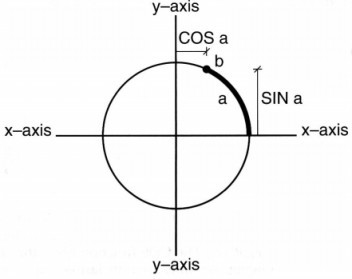The LN Function calculates the natural logarithm (Naperian logarithm) of the given value. For example:
E> Print Ln(10) A#=Ln(100) : Print A#
Trigonometry
The AMOS Professional trigonometric functions are often used for calculating angles,
creating graphic design effects, calculating trajectories in gameplay, as well as making intricate
musical wave forms.
Pi#
function: return a constant &pi
p#=Pi#
Pi is the Greek letter it that is used to summon up a number which begins 3.141592653 and on for ever. This number is the ratio of the circumference of a circle to its diameter, and it is used in trigonometry as the tool for calculating aspects of circles and spheres. Note that in order to avoid clashes with your own variable names, a # character is part of the token name. The PI# function gives a constant value of Pi in your calculations.
In the following diagram of a circle, a point is moved from the right hand side of the x-axis up along the perimeter for a distance a, stopping at position b.

In conventional trigonometry, a circle is divided into 360 degrees, so a defines the number of degrees in the angle between the x-axis and the line from the centre of the circle to point b. However, your Amiga uses a default by which it expects all angles to be given in "radians" and not degrees.